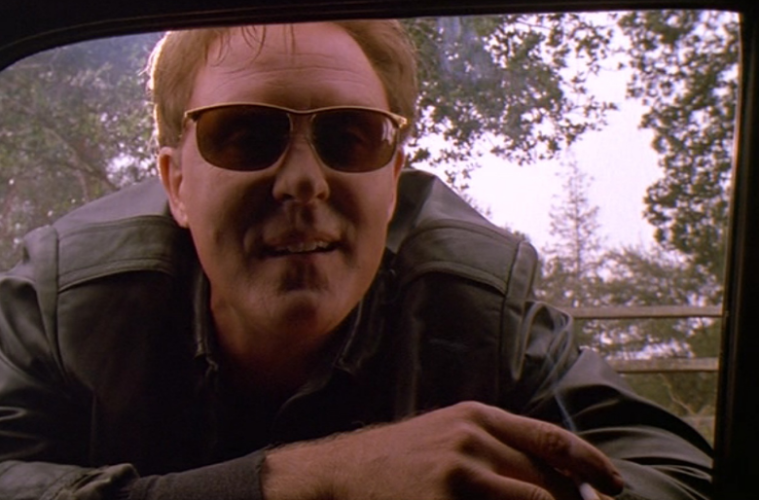
These days, there’s the buffer of Redacted to shore up Brian De Palma’s credentials as a Godardian ironist. Perhaps in the time when it was fashionable for high-minded critics to bolster De Palma’s significance while decrying the filmmakers he cited as influences, the takedowns by card-carrying auteurists might have seemed a necessary antidote to all the doting. De Palma long represented the negative end of a New Hollywood excess, championed by one side of a polemic and lambasted by the other.
De Palma’s bad taste and his love of schlock discounted him from the pantheon erected by auteurists, while the same characteristics attracted the attentions of less-serious-minded populist critics, who saw the director’s near-indistinguishable alternations between facetiousness and sincerity as a plus. Still, even these De Palma diehards generally struggled to explain why he was significant, outside of an anti-intellectual impulse towards celebrating baroque kitsch as an alternative to a high-art strawman. Meanwhile, the auteurist crowd simply struggled to take him seriously. But years passed, as did the critics on both sides, and De Palma’s reputation mellowed and calcified. The political rebel of the movie brat coterie had been replaced by a neutered version of same; the provocateur De Palma had become the emboldened auteur De Palma behind a string of bloated classics. In 2007, Redacted, at least for the few who saw it, evoked the spectre of De Palma’s forgotten home movies (Dionysus in ‘69; Greetings; Hi, Mom!); suddenly, it somehow seemed impossible to ever see the movies — the white elephants and termites both — in quite the same way again.
So if Raising Cain felt, in 1992, like the timely corollary of a waning New Hollywood, where the star directors of the past two decades were forced to exploit the expressive possibilities of genre fare rather than try to recover the noble territory of the ’70s mainstream arthouse, today it plays as a kind of exaggerated, experimental collage of these same forms and feelings — in other words, its own kind of home movie. As in his even better Femme Fatale or in Michael Cimino and John Carpenter’s parallel excursions into lower- and lower-budget material, there’s no pretense of good taste; De Palma takes the generic skeleton as a starting point, using the tropes as a bulwark to riff against. It’s all dotted surface feeling: paranoia, dread, elation. Never mind that little of it makes sense, tonally or narratively. As the film’s warring moods clash scene by scene, so do the rise and fall of John Lithgow’s various acting styles. In maybe his best performance, Lithgow seems to take the spirit of this movie very seriously, playing each role with an ironic commitment (or a committed irony) that makes a stage of every scene’s tawdriness. His criss-crossing affectations redouble De Palma’s efforts to turn Cain into a rather ostentatious spin (is there any other kind?) on the very idea of role-playing — that is, the power to rewrite the late-night television-movie world these characters inhabit as a shabby excuse to step into a new role, fill out another wig, and illuminate some surface-level sentiment peddled by the genre and by De Palma both.
What’s oddest about De Palma’s sublime experimental film, like several of his others — Body Double, Snake Eyes, Femme Fatale — is the pitless audacity of the thing. Never afraid to come off sounding superficial, De Palma’s best ideas are also his dumbest, suggesting feelings and forms as the true subject over any kind of theorized schema. Within this demented confusion of a thriller narrative, an abundance of ambiguous images hint at the representational experimentations sub-Cain: the ghostly images of the baby monitor — a Nosferatu-like Lithgow blurrily gliding around in a sea of pixels — that reappear again and again; the reimagining of Psycho’s swamp-sinking sedan as a cheapened, morbid image of evil, a flailing victim reawakening from the dead and pawing desperately, vengefully at the rear window; a psychiatrist’s fingertips pressed against the glass screen of a television set, recovering one image of a person in another; the urine-green hue of the final motel set-piece, as characters and objects alike glissade into position within De Palma’s great mechanism of simultaneous sensation. But any distinctions between these glimpses of ’70s-era audacity, the time when the sheer weirdness of American cinema gave way to whole works in this style (Carrie, Obsession, The Fury), and the VHS-era banality of Raising Cain’s production are challenged and dissolved in De Palma’s ode to these, his pet forms — all in this glorious, purgatorial, perfunctory waltz of the senses.
Continue reading our career-spanning retrospective, The Summer of De Palma, below.


